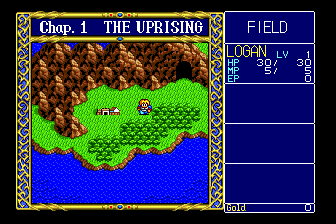
|
For some reason, the Japanese PC game market just never really caught on. While companies such as Konami and Square heavily supported computers like the MSX or PC88, most developers to quick to abandon these platforms in favor of console development. One of the only companies that stuck with it was Nihon Falcom. While its most of Falcom's works have been ported to various consoles by other developers, a vast majority of their titles were developed for Japanese home computers. For Westerners, this has proven to be a problem - while they've made some incredible games, very few of them ever left their home country,
Many of their games were made for operating systems unknown outside of Japan, and their console ports often came out too late, making them look too dated for American publishers to pick them up. Today, Falcom is one of the only companies that makes actual games and not bullshit hentai titles like a vast majority of the Japanese PC market.
Their flagship title has almost always been Ys, a fun little action-RPG series that has seem some exposure in the West. But their secondary title has been Legend of Heroes, a traditional console-style RPG similar to Dragon Warrior. The first game in the series under the "Dragon Slayer" moniker received several ports, but only Turbografx-16 version was translated in English. Since then, the games have never left Japan. This is changing very shortly, as Bandai is releasing Legend of Heroes IV: The Tear of Vermillion for the PSP this holiday season.
Falcom's "Dragon Slayer" line is a little bit odd, since none of the games are actually related. Beginning with an overhead dungeon crawler named, appropriately enough, "Dragon Slayer", the series continued with different action/RPG hybrids, including Xanadu, Sorcerian, The Drasle Family (known as Legacy of the Wizard in America) and others. The early games shared much the same staff, and you can find small similarities in graphics and music between them. Only the first two games in the Legend of Heroes series bear the "Dragon Slayer" moniker. The third title was the start of the "Garghav Trilogy", which all take place in the same game world. For reference, the Dragon Slayer line looks something like this:
I: Dragon Slayer
II: Xanadu
III: Romancia
IV: Drasle Family (Legacy of the Wizard)
V: Sorcerian
VI: Legend of Heroes
VII: Lord Monarch
VIII: Legend of Xanadu
|
|
Dragon Slayer - Legend of Heroes - MSX/PC88/PC98/Mega Drive/Super Famicom/Playstation
Saturn/Windows

PC Engine Cover
|
Sega Saturn Cover
|

Legend of Heroes TG16
|
|
Dragon Slayer: Legend of Heroes is pretty much a
Dragon Warrior clone - this should be apparent the
minute you see the first person battle scenes against
the sparse black background.
As expected from a Falcom
game, the music is excellent, which is enough to give
it something of a unique identity. The graphics are
pretty unimpressive, but even on the lower-end
platforms, they manage to look superior to Enix's
venerable series. You'll eventually have up to four
party members at once, and you can choose to
distribute statistics at each level up, giving you
some semblance of customizability. There are some
slight enhancements - you can target each enemy
directly, and enemy HP is displayed below each
monster. If you get killed - and you will, quite often
- you're politely given the option to return back to
the nearest town or try the battle again. The highly
customizable auto-battle system ensures that fights
move quickly, but the encounter rate is still quite
high. Other than these conveniences, there is very
little that's radically different in Legend of Heroes.
It's easy to imagine that it was a competent RPG at
the time, but it comes off today as a bland, level
grinding exercise in annoyance.
Initially released for the PC88, PC99 and MSX home computers, it was undoubtedly meant to satiate the hunger of role players who, for some reason, didn't have a Famicom or Super Famicom. As a result, it loses a bit of luster when compared to various other console RPGs.
After all, why play a Dragon Quest knockoff when you can actually play Dragon Quest?
American gamers are most likely familiar with the Turbografx-16 port, the only version of the game released in America. Like most games localized by NEC, the voice acting is atrocious, featuring some of the worst Irish accents known to mankind. While cinema scenes are sparse, it does feature an excellent redbook audio soundtrack, rearranged by Ryo Yonemitsu of Ys fame. These features alone made it one of the premiere RPGs on the PC Engine.
The Super Famicom port is completely appalling, with
awful graphics and terrible music. The only real
advantage is that it's one of the only versions with
background graphics in the battle scenes. The Mega
Drive port, reprogrammed by Sega, is actually the best
looking of the bunch. It removes the huge status
windows and puts the action full screen, with huge,
colorful character sprites, and music which is pretty
similar to the PC98 original. While the Playstation
and Saturn ports feature both Legend of Heroes I & II
on the same disc, it's still an inexplicably shoddy
conversion, with unforgivably choppy animation and
graphics that are inferior to the original PC
versions. Despite the archaic graphics, the music is
still high quality streamed audio, although the
arrangements aren't quite as good as the TG16 versions.
|

Legend of Heroes TG16

Legend of Heroes TG16

Legend of Heroes TG16
|
Dragon Slayer: Legend of Heroes - Screenshot Comparisons
Town

|

|

|
|
PC88
|
X68000
|
MSX
|

|

|

|
|
Mega Drive
|
Turbografx-16 CD
|
Super Famicom
|

|
|
|
|
Playstation
|
|
|
Battle

|

|

|
|
PC88
|
X68000
|
MSX
|

|

|

|
|
Mega Drive
|
Turbografx-16 CD
|
Super Famicom
|

|
|
|
|
Playstation
|
|
|
Back to the main page
|




















